A hybrid method based on genetic algorithm and ant colony system for traffic routing optimization
This paper presents a hybrid method that combines the genetic algorithm (GA) and the
ant colony system algorithm (ACS), namely GACS, to solve the traffic routing problem. In the
proposed framework, we use the genetic algorithm to optimize the ACS parameters in order to
attain the best trips and travelling time through several novel functions to help ants to update the
global and local pheromones. The GACS framework is implemented using the VANETsim
package and the real city maps from the open street map project. The experimental results show
that our framework achieves a considerably higher performance than A-Star and the classical ACS
algorithms in terms of the length of the global best path and the time for trips. Moreover, the
GACS framework is also efficient in solving the congestion problem by online monitoring the
conditions of traffic light systems.
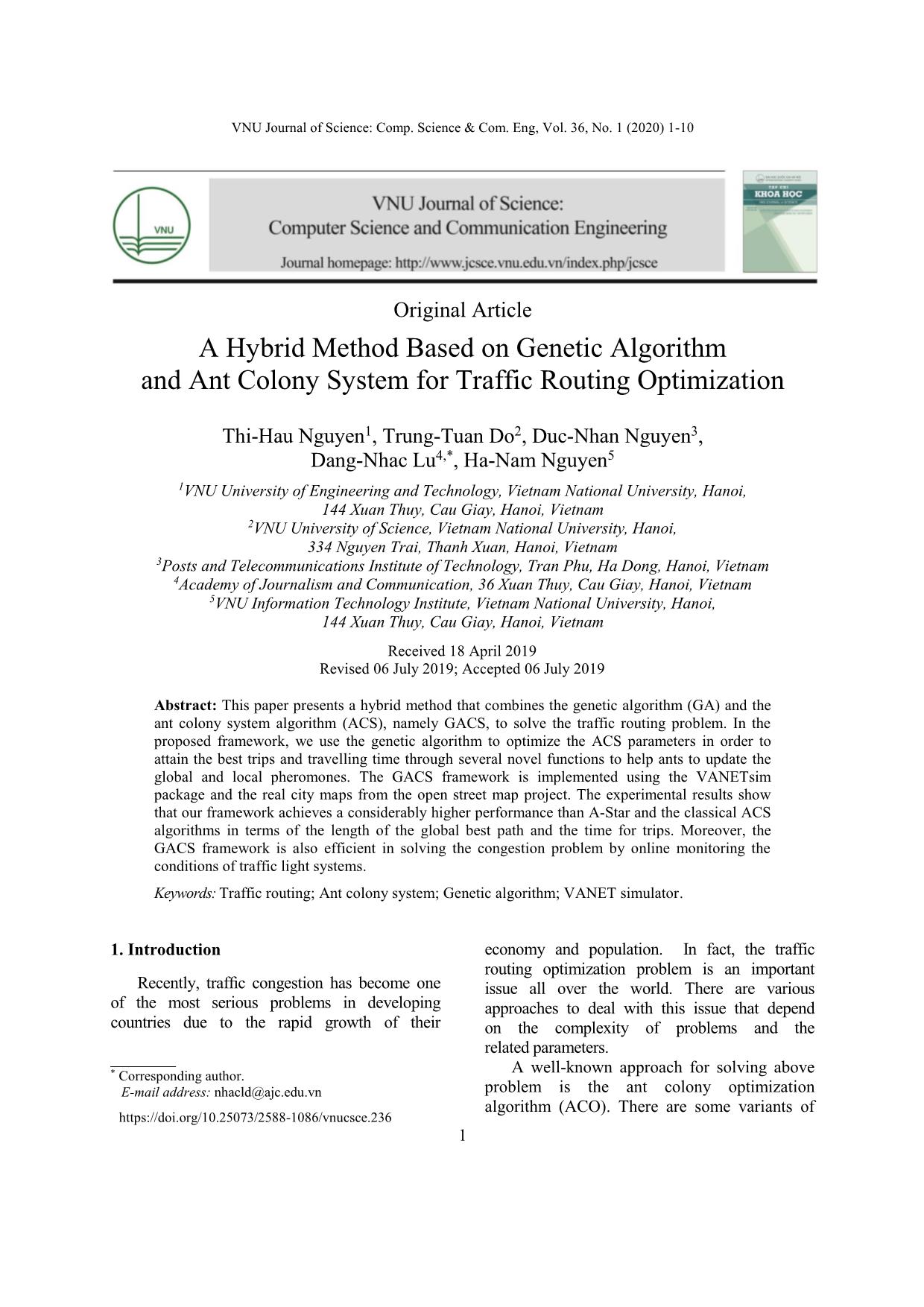
Trang 1

Trang 2
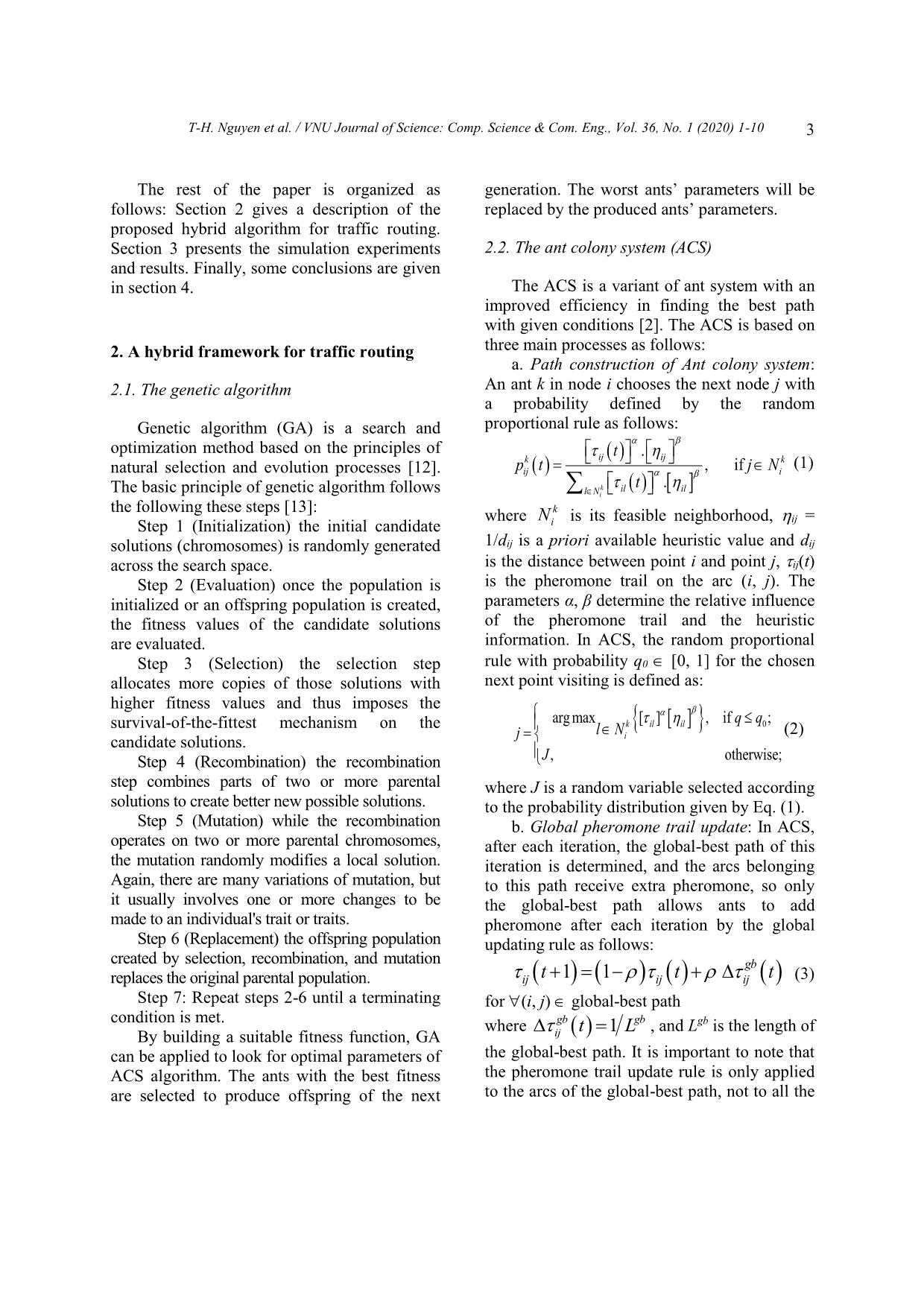
Trang 3
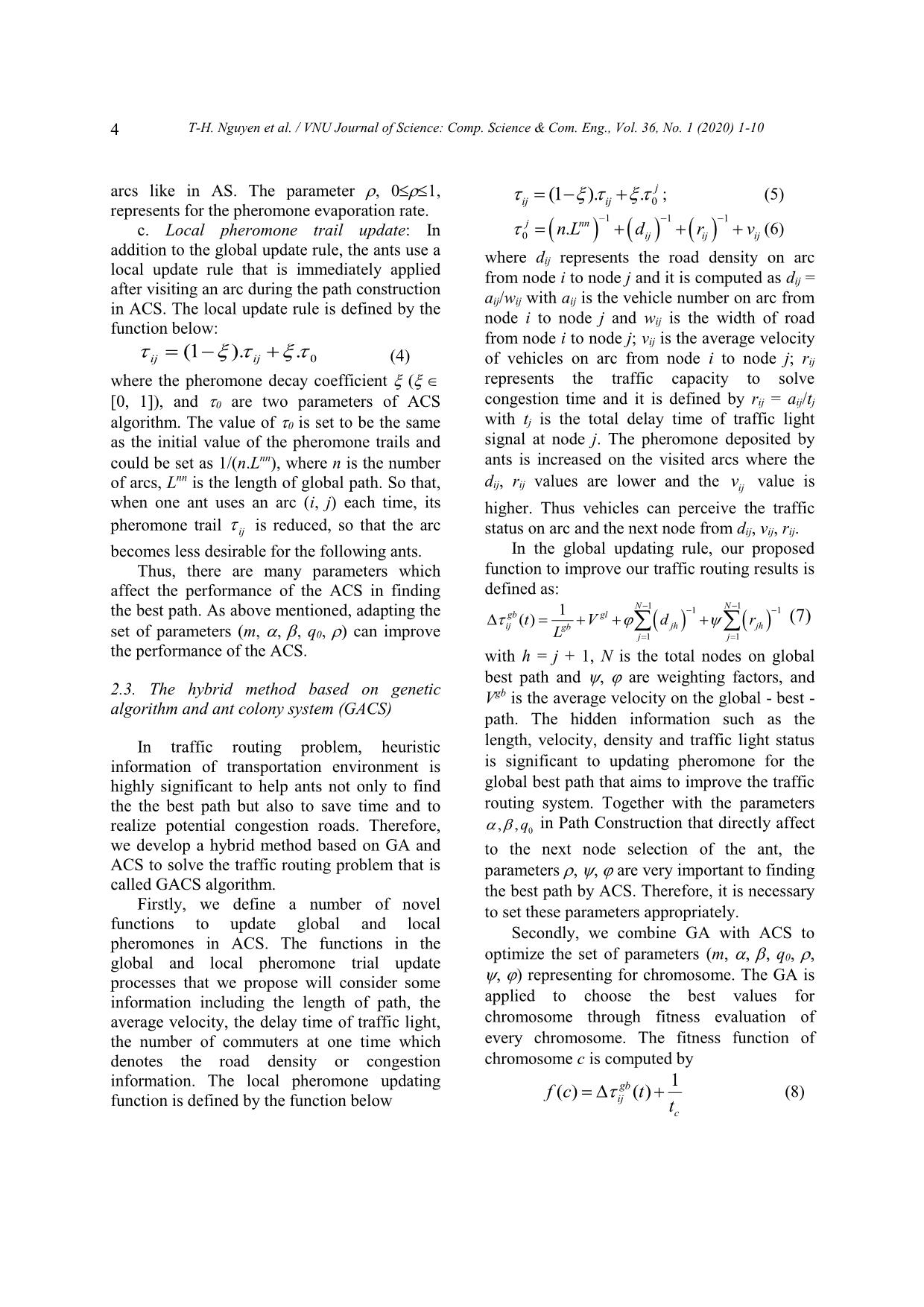
Trang 4
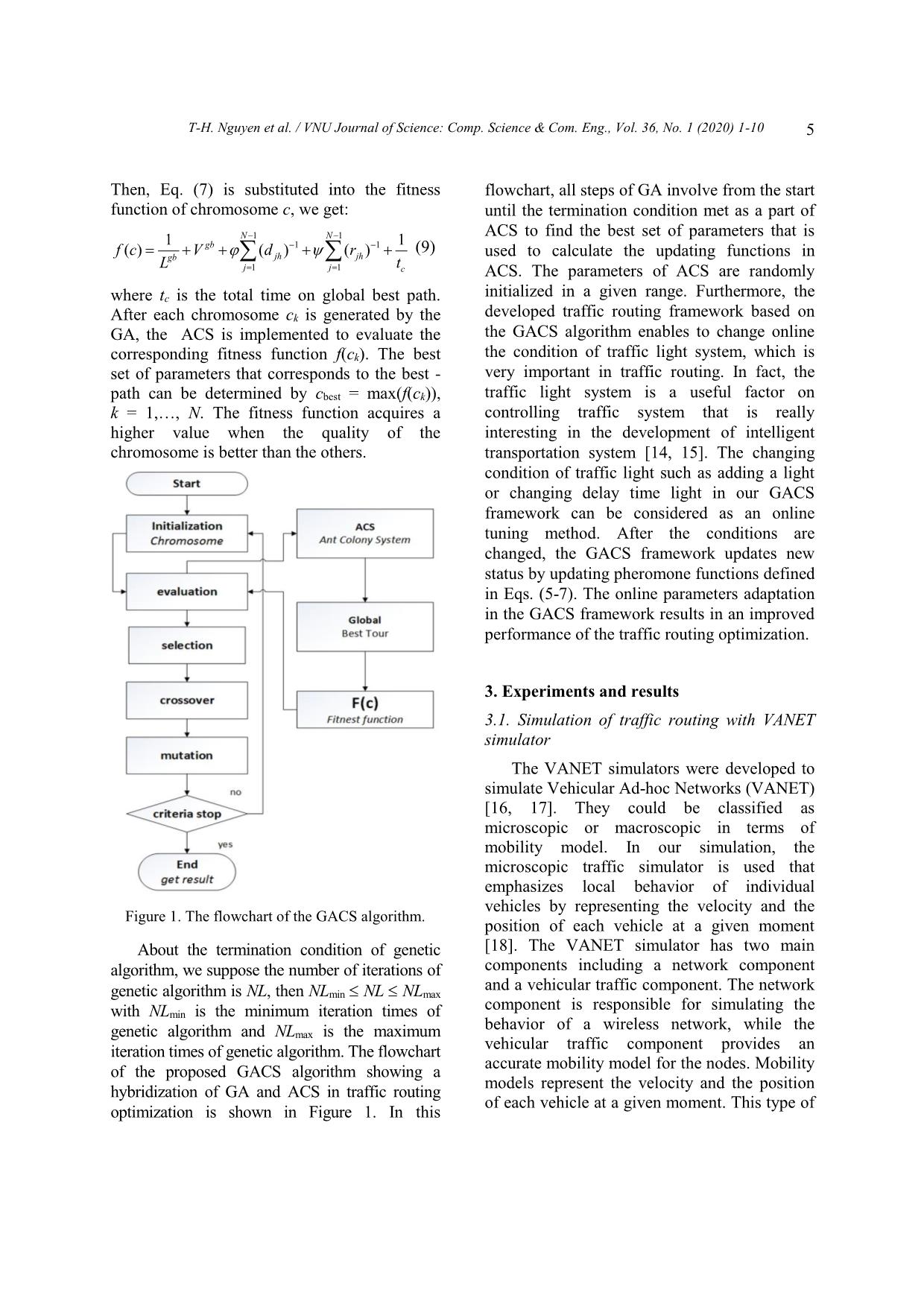
Trang 5

Trang 6
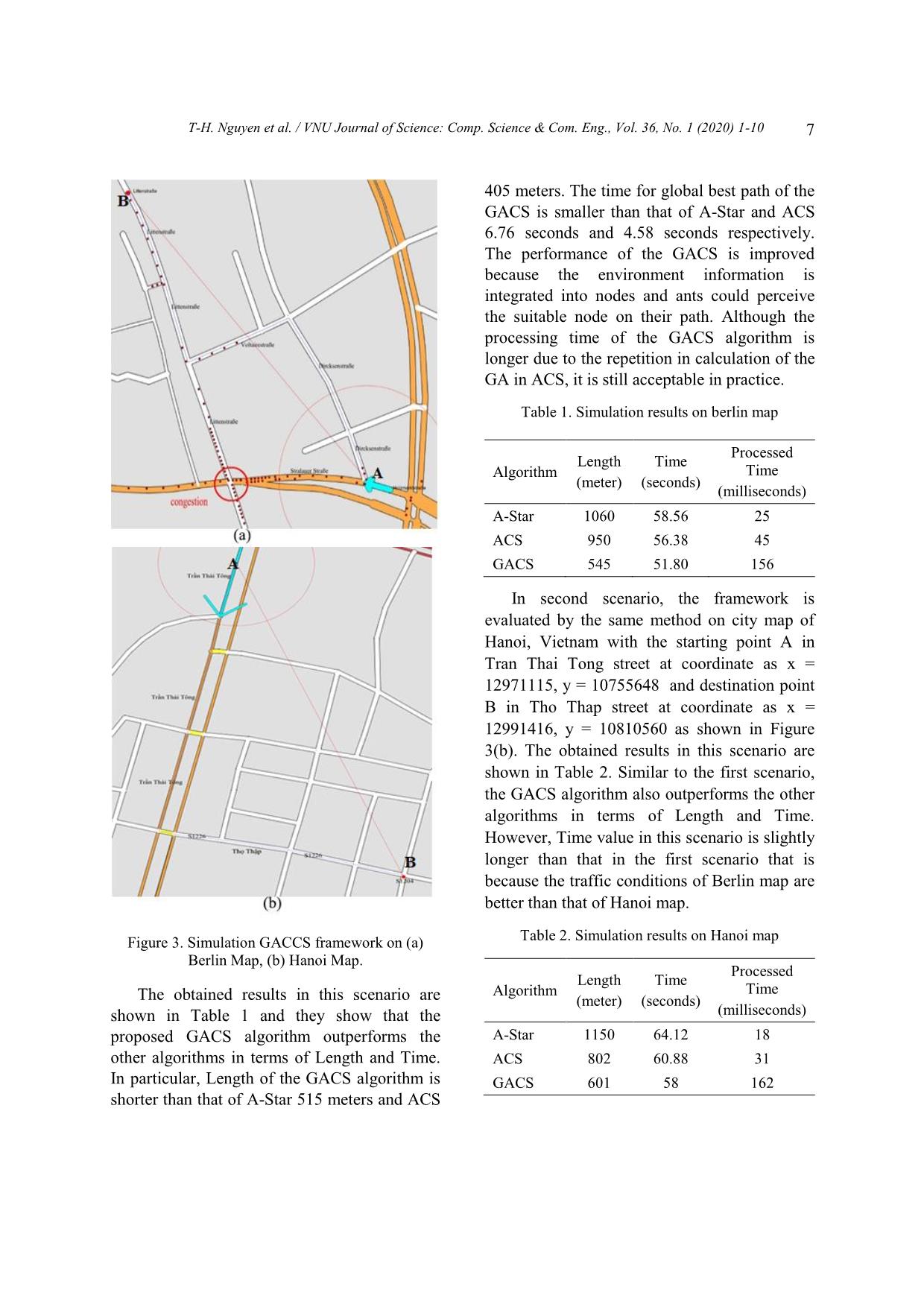
Trang 7
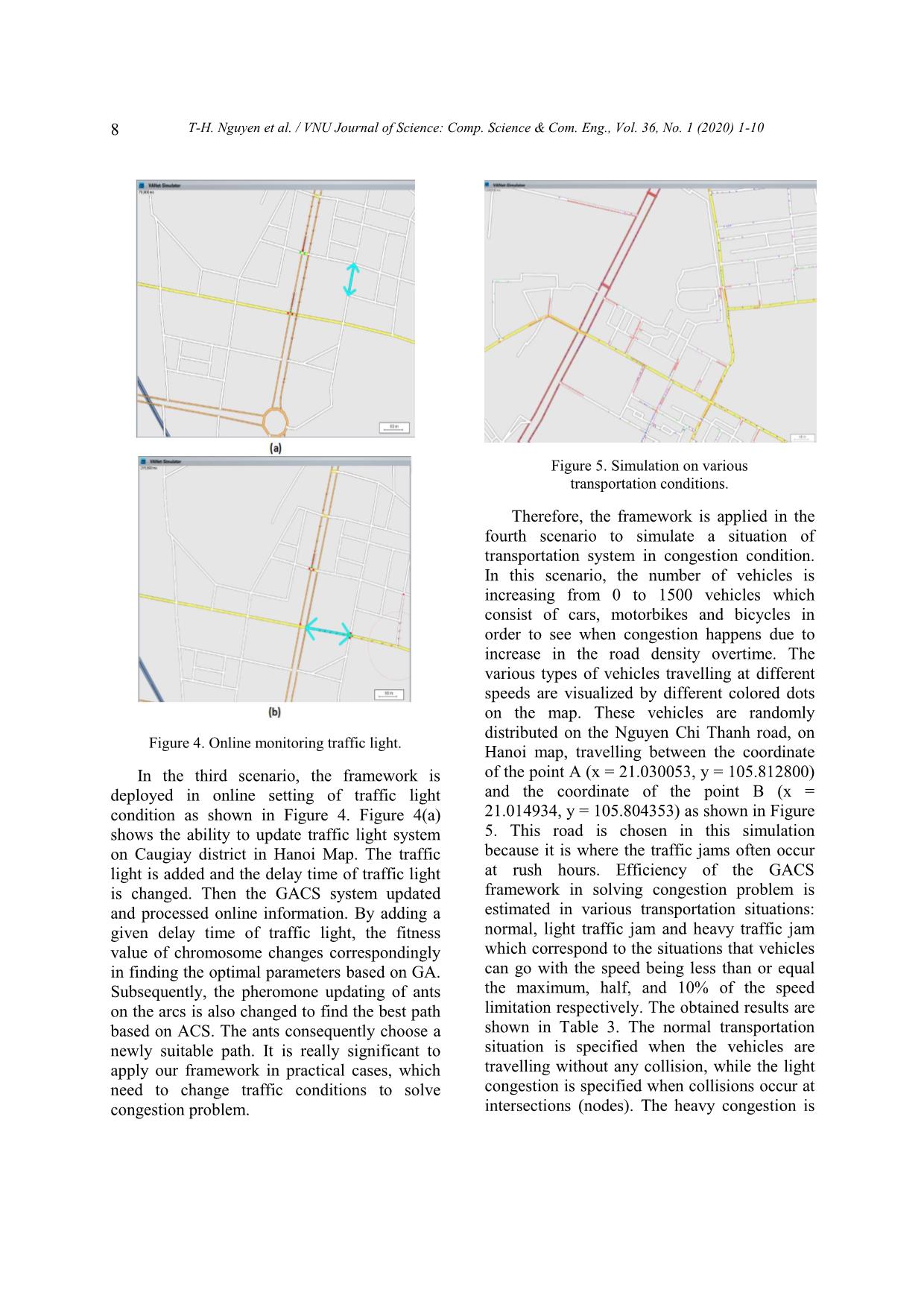
Trang 8
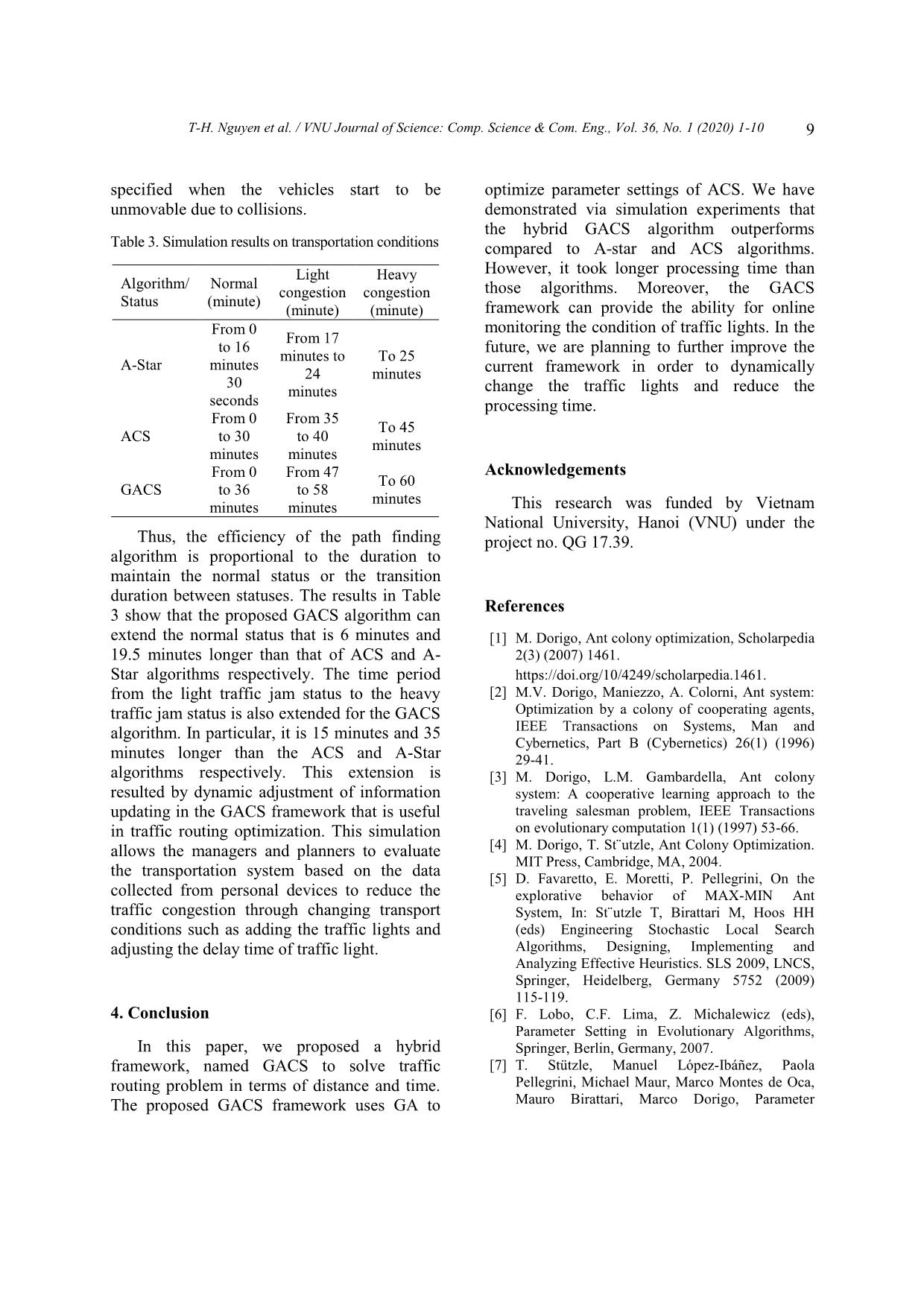
Trang 9
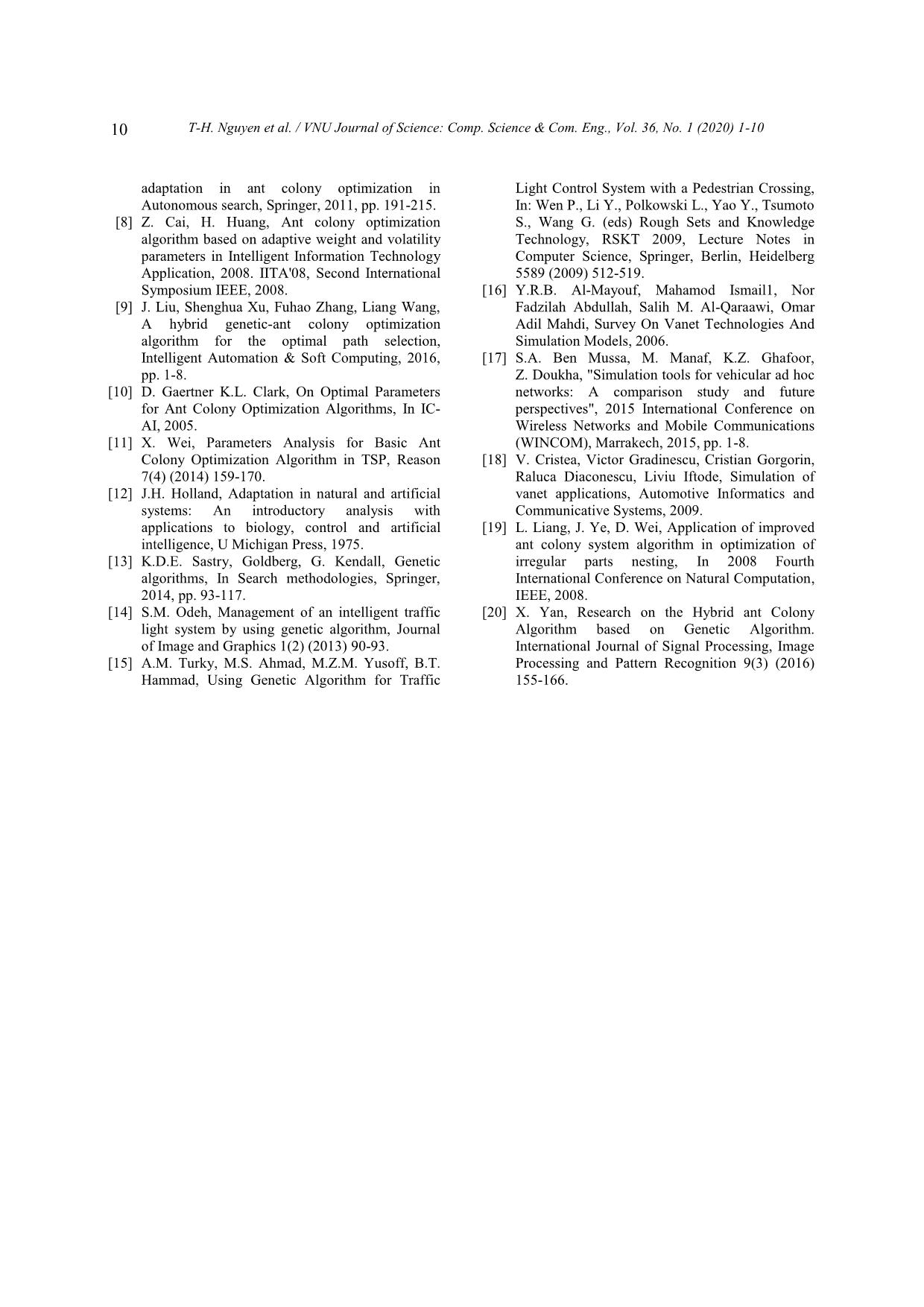
Trang 10
Tóm tắt nội dung tài liệu: A hybrid method based on genetic algorithm and ant colony system for traffic routing optimization
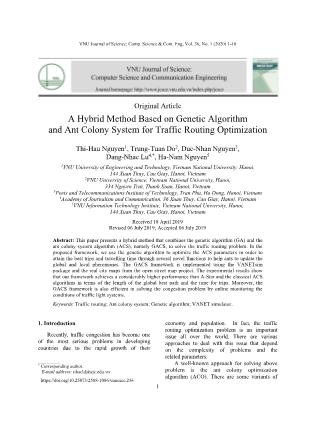
or has two main algorithm, we suppose the number of iterations of components including a network component and a vehicular traffic component. The network genetic algorithm is NL, then NLmin NL NLmax component is responsible for simulating the with NLmin is the minimum iteration times of behavior of a wireless network, while the genetic algorithm and NLmax is the maximum iteration times of genetic algorithm. The flowchart vehicular traffic component provides an accurate mobility model for the nodes. Mobility of the proposed GACS algorithm showing a models represent the velocity and the position hybridization of GA and ACS in traffic routing of each vehicle at a given moment. This type of optimization is shown in Figure 1. In this 6 T-H. Nguyen et al. / VNU Journal of Science: Comp. Science & Com. Eng., Vol. 36, No. 1 (2020) 1-10 simulation is especially helpful to traffic appropriate set of parameter values and their routing problem. range of values are initially selected in our The microscopic VANET simulator in experiments. With chromosome (m, , , q0, , traffic routing problem considers vehicles as , ) of GACS algorithm via experiments it distinct entities that could communicate and was shown that the appropriate range for , , share information on traffic density, speed, q0 is from 0 to 1, and is between 1 and 5, and moving direction of vehicles, road and traffic , is between 1 and 10. At last, the initial ant light. The simulation on VANET with GACS number of system m is between 1 and 500. The framework we develop includes four modules fitness function is computed by Eq. (9) and the as shown in Figure 2. stopping criteria are NLmin = 10 and NLmax = 55. MAP module processes the map problem to The simulation experiments run on get and transform map from an open street map Windows 7 OS, Intel Core i7-6700 (3.4 Ghz, project, load and visualize agent activity. It also 8M Cache) processor, 16GB DDR3L RAM. establishes online changing traffic conditions Our simulation framework is developed using such as traffic light, road and traveling Open JDK Java 8 environment and VANETsim environment attributes. version 1.3. The types of vehicles include motorbike, bicycle, car and bus, with total number of them between 10 and 100. The performance of the system is evaluated by criteria such as the total length of vehicle from starting point to destination, the time for this trip and the time that is used for algorithm processing. The results obtained from our framework are then compared to A-Star and ACS algorithms. 3.3. Results and analysis Figure 2. VANET simulation system with In the first scenario, we evaluated on the city routing algorithms. map of Berlin, Germany, in which the data is loaded from open street map, then it randomized AGENT module constructs agents from types the starting point A with coordinate as x = 582858 of traffic vehicles with attributes on system, and y = 353950 on Holzmarktstrasse road and controlling agent behaviors and traffic conditions. destination B on Littenstrasse with coordinate as GUI module processes visualization graphic x = 550418, y = 320967. The GACS framework information and provides interaction ability selected the trip to travel from A to B as shown in between user and the system. Figure 3(a). When the vehicles meet congestion at ROUTING module processes the algorithms and returns the results to the system. the intersections between StralauerStrasse and In this module, beside the proposed GACS Littenstrasse, they reroute the path with updated algorithm, the A-Star and ACS algorithms are information. The new routing will be changed to also used for performance comparison. the Direksenstrasse road to complete their trip. Experimental results are evaluated in terms of 3.2. Experimental parameters three values including Length (the length of the global best path), Time (the time of best path), Based on the parameters analysis in [7, 11, Processed Time (the processing time of 19, 20] which obtained remarkable results, the the system). T-H. Nguyen et al. / VNU Journal of Science: Comp. Science & Com. Eng., Vol. 36, No. 1 (2020) 1-10 7 405 meters. The time for global best path of the GACS is smaller than that of A-Star and ACS 6.76 seconds and 4.58 seconds respectively. The performance of the GACS is improved because the environment information is integrated into nodes and ants could perceive the suitable node on their path. Although the processing time of the GACS algorithm is longer due to the repetition in calculation of the GA in ACS, it is still acceptable in practice. Table 1. Simulation results on berlin map Processed Length Time Algorithm Time (meter) (seconds) (milliseconds) A-Star 1060 58.56 25 ACS 950 56.38 45 GACS 545 51.80 156 In second scenario, the framework is evaluated by the same method on city map of Hanoi, Vietnam with the starting point A in Tran Thai Tong street at coordinate as x = 12971115, y = 10755648 and destination point B in Tho Thap street at coordinate as x = 12991416, y = 10810560 as shown in Figure 3(b). The obtained results in this scenario are shown in Table 2. Similar to the first scenario, the GACS algorithm also outperforms the other algorithms in terms of Length and Time. However, Time value in this scenario is slightly longer than that in the first scenario that is because the traffic conditions of Berlin map are better than that of Hanoi map. Figure 3. Simulation GACCS framework on (a) Table 2. Simulation results on Hanoi map Berlin Map, (b) Hanoi Map. Processed Length Time Algorithm Time The obtained results in this scenario are (meter) (seconds) shown in Table 1 and they show that the (milliseconds) proposed GACS algorithm outperforms the A-Star 1150 64.12 18 other algorithms in terms of Length and Time. ACS 802 60.88 31 In particular, Length of the GACS algorithm is GACS 601 58 162 shorter than that of A-Star 515 meters and ACS y 8 T-H. Nguyen et al. / VNU Journal of Science: Comp. Science & Com. Eng., Vol. 36, No. 1 (2020) 1-10 Figure 5. Simulation on various transportation conditions. Therefore, the framework is applied in the fourth scenario to simulate a situation of transportation system in congestion condition. In this scenario, the number of vehicles is increasing from 0 to 1500 vehicles which consist of cars, motorbikes and bicycles in order to see when congestion happens due to increase in the road density overtime. The various types of vehicles travelling at different speeds are visualized by different colored dots on the map. These vehicles are randomly distributed on the Nguyen Chi Thanh road, on Figure 4. Online monitoring traffic light. Hanoi map, travelling between the coordinate In the third scenario, the framework is of the point A (x = 21.030053, y = 105.812800) deployed in online setting of traffic light and the coordinate of the point B (x = condition as shown in Figure 4. Figure 4(a) 21.014934, y = 105.804353) as shown in Figure shows the ability to update traffic light system 5. This road is chosen in this simulation on Caugiay district in Hanoi Map. The traffic because it is where the traffic jams often occur light is added and the delay time of traffic light at rush hours. Efficiency of the GACS is changed. Then the GACS system updated framework in solving congestion problem is and processed online information. By adding a estimated in various transportation situations: given delay time of traffic light, the fitness normal, light traffic jam and heavy traffic jam value of chromosome changes correspondingly which correspond to the situations that vehicles in finding the optimal parameters based on GA. can go with the speed being less than or equal Subsequently, the pheromone updating of ants the maximum, half, and 10% of the speed on the arcs is also changed to find the best path limitation respectively. The obtained results are based on ACS. The ants consequently choose a shown in Table 3. The normal transportation newly suitable path. It is really significant to situation is specified when the vehicles are apply our framework in practical cases, which travelling without any collision, while the light need to change traffic conditions to solve congestion is specified when collisions occur at congestion problem. intersections (nodes). The heavy congestion is T-H. Nguyen et al. / VNU Journal of Science: Comp. Science & Com. Eng., Vol. 36, No. 1 (2020) 1-10 9 specified when the vehicles start to be optimize parameter settings of ACS. We have unmovable due to collisions. demonstrated via simulation experiments that the hybrid GACS algorithm outperforms Table 3. Simulation results on transportation conditions compared to A-star and ACS algorithms. Light Heavy However, it took longer processing time than Algorithm/ Normal congestion congestion those algorithms. Moreover, the GACS Status (minute) (minute) (minute) framework can provide the ability for online From 0 monitoring the condition of traffic lights. In the From 17 to 16 future, we are planning to further improve the minutes to To 25 A-Star minutes 24 minutes current framework in order to dynamically 30 minutes change the traffic lights and reduce the seconds processing time. From 0 From 35 To 45 ACS to 30 to 40 minutes minutes minutes From 0 From 47 Acknowledgements To 60 GACS to 36 to 58 minutes minutes minutes This research was funded by Vietnam National University, Hanoi (VNU) under the Thus, the efficiency of the path finding project no. QG 17.39. algorithm is proportional to the duration to maintain the normal status or the transition duration between statuses. The results in Table References 3 show that the proposed GACS algorithm can extend the normal status that is 6 minutes and [1] M. Dorigo, Ant colony optimization, Scholarpedia 19.5 minutes longer than that of ACS and A- 2(3) (2007) 1461. Star algorithms respectively. The time period https://doi.org/10/4249/scholarpedia.1461. from the light traffic jam status to the heavy [2] M.V. Dorigo, Maniezzo, A. Colorni, Ant system: traffic jam status is also extended for the GACS Optimization by a colony of cooperating agents, algorithm. In particular, it is 15 minutes and 35 IEEE Transactions on Systems, Man and Cybernetics, Part B (Cybernetics) 26(1) (1996) minutes longer than the ACS and A-Star 29-41. algorithms respectively. This extension is [3] M. Dorigo, L.M. Gambardella, Ant colony resulted by dynamic adjustment of information system: A cooperative learning approach to the updating in the GACS framework that is useful traveling salesman problem, IEEE Transactions in traffic routing optimization. This simulation on evolutionary computation 1(1) (1997) 53-66. allows the managers and planners to evaluate [4] M. Dorigo, T. St¨utzle, Ant Colony Optimization. MIT Press, Cambridge, MA, 2004. the transportation system based on the data [5] D. Favaretto, E. Moretti, P. Pellegrini, On the collected from personal devices to reduce the explorative behavior of MAX-MIN Ant traffic congestion through changing transport System, In: St¨utzle T, Birattari M, Hoos HH conditions such as adding the traffic lights and (eds) Engineering Stochastic Local Search adjusting the delay time of traffic light. Algorithms, Designing, Implementing and Analyzing Effective Heuristics. SLS 2009, LNCS, Springer, Heidelberg, Germany 5752 (2009) 115-119. 4. Conclusion [6] F. Lobo, C.F. Lima, Z. Michalewicz (eds), Parameter Setting in Evolutionary Algorithms, In this paper, we proposed a hybrid Springer, Berlin, Germany, 2007. framework, named GACS to solve traffic [7] T. Stützle, Manuel López-Ibáñez, Paola routing problem in terms of distance and time. Pellegrini, Michael Maur, Marco Montes de Oca, The proposed GACS framework uses GA to Mauro Birattari, Marco Dorigo, Parameter 10 T-H. Nguyen et al. / VNU Journal of Science: Comp. Science & Com. Eng., Vol. 36, No. 1 (2020) 1-10 adaptation in ant colony optimization in Light Control System with a Pedestrian Crossing, Autonomous search, Springer, 2011, pp. 191-215. In: Wen P., Li Y., Polkowski L., Yao Y., Tsumoto [8] Z. Cai, H. Huang, Ant colony optimization S., Wang G. (eds) Rough Sets and Knowledge algorithm based on adaptive weight and volatility Technology, RSKT 2009, Lecture Notes in parameters in Intelligent Information Technology Computer Science, Springer, Berlin, Heidelberg Application, 2008. IITA'08, Second International 5589 (2009) 512-519. Symposium IEEE, 2008. [16] Y.R.B. Al-Mayouf, Mahamod Ismail1, Nor [9] J. Liu, Shenghua Xu, Fuhao Zhang, Liang Wang, Fadzilah Abdullah, Salih M. Al-Qaraawi, Omar A hybrid genetic-ant colony optimization Adil Mahdi, Survey On Vanet Technologies And algorithm for the optimal path selection, Simulation Models, 2006. Intelligent Automation & Soft Computing, 2016, [17] S.A. Ben Mussa, M. Manaf, K.Z. Ghafoor, pp. 1-8. Z. Doukha, "Simulation tools for vehicular ad hoc [10] D. Gaertner K.L. Clark, On Optimal Parameters networks: A comparison study and future for Ant Colony Optimization Algorithms, In IC- perspectives", 2015 International Conference on AI, 2005. Wireless Networks and Mobile Communications [11] X. Wei, Parameters Analysis for Basic Ant (WINCOM), Marrakech, 2015, pp. 1-8. Colony Optimization Algorithm in TSP, Reason [18] V. Cristea, Victor Gradinescu, Cristian Gorgorin, 7(4) (2014) 159-170. Raluca Diaconescu, Liviu Iftode, Simulation of [12] J.H. Holland, Adaptation in natural and artificial vanet applications, Automotive Informatics and systems: An introductory analysis with Communicative Systems, 2009. applications to biology, control and artificial [19] L. Liang, J. Ye, D. Wei, Application of improved intelligence, U Michigan Press, 1975. ant colony system algorithm in optimization of [13] K.D.E. Sastry, Goldberg, G. Kendall, Genetic irregular parts nesting, In 2008 Fourth algorithms, In Search methodologies, Springer, International Conference on Natural Computation, 2014, pp. 93-117. IEEE, 2008. [14] S.M. Odeh, Management of an intelligent traffic [20] X. Yan, Research on the Hybrid ant Colony light system by using genetic algorithm, Journal Algorithm based on Genetic Algorithm. of Image and Graphics 1(2) (2013) 90-93. International Journal of Signal Processing, Image [15] A.M. Turky, M.S. Ahmad, M.Z.M. Yusoff, B.T. Processing and Pattern Recognition 9(3) (2016) Hammad, Using Genetic Algorithm for Traffic 155-166. H h
File đính kèm:
 a_hybrid_method_based_on_genetic_algorithm_and_ant_colony_sy.pdf
a_hybrid_method_based_on_genetic_algorithm_and_ant_colony_sy.pdf

